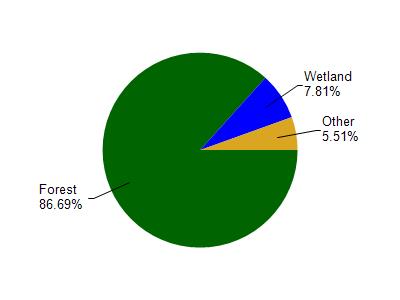Bayfield
Yes
No
No
Fish and Aquatic Life
Overview
This small trout stream flows some four miles from Lenawee Lake to where it joins the East Fork of the Cranberry River. The upper reaches of the stream don't support enough flow to serve as trout waters, but do serve as a trout nursery. At the boundary to the lower reach, springs augment the flow and the stream is littered with boulders, fallen logs and debris that, along with undercut banks, provide abundant in-stream cover.
The lower mile of stream is designated outstanding resource water. About half of the stream's length falls within the Chequamegon National Forest. The upland hardwoods in the watershed are periodically clearcut and sometimes crossed by logging access roads. Photo-revisions of topographic maps in 1975 show Apits@ in Section 24 at the headwaters of an intermittent stream draining from forest land into Lenawee Creek (T49N R7W S16). These warrant evaluation to determine if they have any impact on the trout nursery area in Lenawee Creek.
During survey work conducted as part of the coastal wetlands evaluation, no rare species of macroinvertebrates were found and overall taxa richness was moderate (5-24 species) (Epstein 1997). The survey noted that bank erosion was significant, with silt a concern.
Date 1999
Author Aquatic Biologist
Condition
Wisconsin has over 84,000 miles of streams, 15,000 lakes and milllions of acres of wetlands. Assessing the condition of this vast amount of water is challenging. The state's water monitoring program uses a media-based, cross-program approach to analyze water condition. An updated monitoring strategy (2015-2020) is now available. Compliance with Clean Water Act fishable, swimmable standards are located in the Executive Summary of Water Condition in 2018. See also the 'monitoring and projects' tab.
Reports
Management Goals
Wisconsin's Water Quality Standards provide qualitative and quantitative goals for waters that are protective of Fishable, Swimmable conditions [Learn more]. Waters that do not meet water quality standards are considered impaired and restoration actions are planned and carried out until the water is once again fishable and swimmable
Management goals can include creation or implementation of a Total Maximum Daily Load analysis, a Nine Key Element Plan, or other restoration work, education and outreach and more. If specific recommendations exist for this water, they will be displayed below online.
Monitoring
Monitoring the condition of a river, stream, or lake includes gathering physical, chemical, biological, and habitat data. Comprehensive studies often gather all these parameters in great detail, while lighter assessment events will involve sampling physical, chemical and biological data such as macroinvertebrates. Aquatic macroinvertebrates and fish communities integrate watershed or catchment condition, providing great insight into overall ecosystem health. Chemical and habitat parameters tell researchers more about human induced problems including contaminated runoff, point source dischargers, or habitat issues that foster or limit the potential of aquatic communities to thrive in a given area. Wisconsin's Water Monitoring Strategy was recenty updated.
Grants and Management Projects
| Project Name (Click for Details) | Year Started |
|---|
|
|
Monitoring Projects
| WBIC | Official Waterbody Name | Station ID | Station Name | Earliest Fieldwork Date | Latest Fieldwork Date | View Station | View Data |
|---|
| 2880200 | Lenawee Creek | 10044456 | Lenawee Creek - 1000 ft U/S from Puig Rd | | | Map | Data |
|

Watershed Characteristics
Lenawee Creek is located in the Bayfield Peninsula Northwest watershed which is 236.05 mi². Land use in the watershed is primarily forest (86.60%), wetland (7.80%) and a mix of grassland (4.60%) and other uses (0.90%). This watershed has 473.06 stream miles, 43,216.55 lake acres and 6,677.27 wetland acres.
Nonpoint Source Characteristics
This watershed is ranked Not Ranked for runoff impacts on streams, Not Available for runoff impacts on lakes and Low for runoff impacts on groundwater and therefore has an overall rank of Low. This value can be used in ranking the watershed or individual waterbodies for grant funding under state and county programs.However, all waters are affected by diffuse pollutant sources regardless of initial water quality. Applications for specific runoff projects under state or county grant programs may be pursued. For more information, go to surface water program grants.